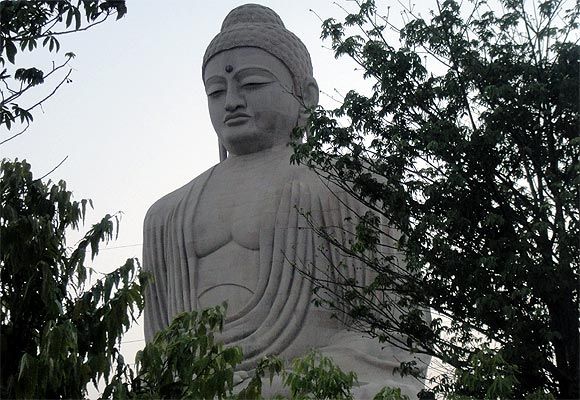'Seven galleries range from the historical to the traditional, and from the contemporary to what constitutes the Diaspora -- the migrant labour that went on to create plantation colonies in far reaches of the world,' notes Kishore Singh.

New Delhi and Mumbai are so insular and self-obsessed, they turn a blind eye to developments in the states that should have us applauding the achievements in which we lag behind.
Three-and-a-half decades ago, the setting up of Bharat Bhavan was touted as a huge achievement in Bhopal, especially since we have created few cultural institutions that were not bequeathed to us by the British, and which we have since let slide into a state of morass and apathy.
Last month, the partially opened Bihar Museum in Patna was declared open to the public.
While its main attraction is being touted as the Didarganj Yakshi, a 2,000-year-old sandstone sculpture of a voluptuous female figure holding a fly whisk -- its comparison with the Louvre's Mona Lisa by a state minister is a mix of hype and misplaced comparison -- there's plenty else in the museum to engage visitors.
In all, seven galleries form part of this sprawling, Rs 521 crore (Rs 5.21 billion) building placed in the heart of the Bihar capital in four sections that range from the historical to the traditional, and from the contemporary to what constitutes the Diaspora -- the migrant labour that went on to create plantation colonies in far reaches of the world a few centuries ago.
While little is known about its acquisition process -- the museum is being touted essentially as a symbol of Bihari pride, and therefore limited by that focus -- the shifting of post-1764 artefacts from the Patna Museum to the Bihar Museum is being seen by some intellectuals as disruptive.
Though pre-1764 artefacts will remain in the Patna Museum, there is the question of why a new museum should not have its own substantial funds to make fresh acquisitions for its collection.
There is no doubt that airing works lying in the vaults of the Patna Museum has merit. But it isn't as if the Bihar Museum is not reaching out with newer attractions.
As many as 25 artists of Bihari origin have contributed to the museum's contemporariness.
Notable among them are Subodh Gupta whose yantra has been installed and Sanjay Gupta whose massive 'begging bowl' installation, which he has surrounded with 171 figures of Buddhist monks in brass, recalls the state's association with the Buddha as well as Ashoka.
Designed by the Japan-based Maki and Associates, the museum building is a modern take on the state's traditional as well as classical architecture.
Personally overseen by the state chief minister, the museum charges Rs 100 per ticket (Rs 500 for foreigners), but is currently short on visitor information. That has not discouraged queues at the gate, for it is Patna's -- and the provincial government's -- attempt to create a world-class institution with which to engage, and encourage, the local populace.
Whether it achieves this mandate will depend to a large extent on the team that will man the institution, and one can only hope it rises beyond purely local aspirations.
Outside Patna too, in Odisha, Jyotindra Jain is working on a museum for the government that will, no doubt, involve the folk and the tribal, areas in which his expertise remains unchallenged.
But even as state governments are addressing concerns about representing local cultures and art, New Delhi and Mumbai are falling behind, having created no new institutions.
Mumbai has at least the renovated and renamed Dr Bhau Daji Lad (formerly the Victoria & Albert) Museum to its credit, but in New Delhi, the seat of two governments, the lack of any new art institutions is a glaring example of how apathetic we are to the arts.
Making a case of learning, by instance, from Bihar.
Kishore Singh is a Delhi-based writer and art critic. These views are personal and do not reflect those of the organisation with which he is associated.
IMAGE: An imposing statue of the Buddha in Bodh Gaya, Bihar, one of Buddhism's most holy sites. Photograph: Archana Masih/Rediff.com











